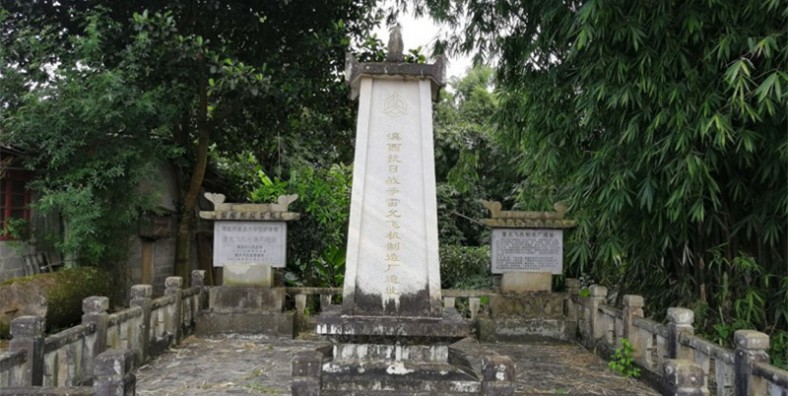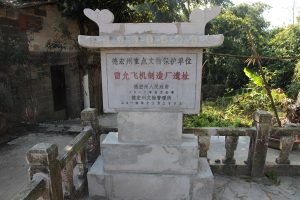 alt="Puer Surrounding Counties and Towns: Weekly & Special Local Markets Travel Guide"
/>
alt="Puer Surrounding Counties and Towns: Weekly & Special Local Markets Travel Guide"
/>
The Site of Loiwing Central Aircraft Manufacturing Company in Ruili City

Attractions Overview
In 1938, it built a new factory a further 1500km west on the China-Burma frontier at Loiwing, which opened in early 1939. In the winter of 1940-1941, CAMCO also became involved in recruitment and supply for the 1st American Volunteer Group (AVG), later known as the Flying Tigers. The CAMCO factory at Loiwing was virtually destroyed by a Japanese air strike in October 1940, and "was rebuilt as a maintenance and repair facility for the [Chinese Air Force]"; subsequently it was used to repair AVG P-40s, and its airfield was briefly used by the AVG to mount raids into Thailand and Burma. Following the Allied retreat from Burma in the spring of 1942, the Loiwing plant was lost to the Japanese.
Chinese Name:瑞丽雷允中央飞机制造厂(Pinyin: Ruili Leiyun Zhongyang Feiji Zhizaochuang)
English Name: The Site of Loiwing Central Aircraft Manufacturing Company in Ruili City, Dehong
Attraction Type: Historical site
Best Time to Visit: All year round
Recommended Visiting Time: under 1 hour
Opening Hours: All day long
Admission Fee: Free
Address: Loiwing Village, Ruili City, Dehong Jingpo and Dai Autonomous Prefecture, Yunnan(云南省德宏傣族景颇族自治州瑞丽市雷允村)
🌟 Key Highlights
🛩️ Milestone of China’s Wartime Aviation Industry
Originally established in 1934 as the Central Hangzhou Aircraft Manufacturing Plant in Jianqiao, Hangzhou, the factory relocated and expanded in 1939 to Leiyun Village, Ruili. During the War of Resistance against Japan, it became China’s largest and most advanced aviation manufacturing base, covering over 1,000 acres.
A joint Chinese-American operation, it employed over 2,500 workers and assembled or repaired more than 200 military aircraft, including the Hawk-3 fighter and CW-21 interceptor, critical for early air defense.
In 1942, the factory was deliberately destroyed to prevent capture as Japanese forces advanced into Burma, operating only three years.
🏭 Remaining Industrial Relics
-
The 1,000㎡ concrete apron and runway remnants still bear the clear inscription “CAMC 1939” (Central Aircraft Manufacturing Corporation).
-
Foundations of the cooling workshop and blast-proof walls of the machine repair plant remain, showcasing heavy wartime construction (notably, Hangzhou’s original oil depot walls were 0.8m thick).
-
A white marble monument was erected in 2001, engraved with a propeller symbol and commemorative text.
-
Rusted parts and tools collected by local guardian Peng Liang are on display, offering an intimate look at wartime production.
🔧 Historical Impact & Technical Breakthroughs
-
Pioneered localized improvements on American production lines; in 1939, the CW-21 interceptor set an Asian climb rate record of 1,067 meters per minute.
-
Served as a training ground for aviation pioneers like Qian Xuesen (who participated in assembly) and Xu Shunshou, the chief designer of China’s first jet aircraft.
-
Provided maintenance support to the Flying Tigers, the British Royal Air Force, and even Chiang Kai-shek’s special aircraft.

📍 Visiting Information
🚗 Location & Transport
-
Address: Leiyun Village, Nongdao Town, Ruili City, Yunnan Province, along the Nanwan River at the China-Myanmar border.
-
Getting there: About a 1-hour drive from downtown Ruili. Navigate via “Leiyun Aircraft Manufacturing Plant Ruins”. Round-trip car hire costs around ¥150.
🏞️ Ruins Overview
| Area | Remains | Visitor Tips |
|---|---|---|
| Factory Site | “CAMC 1939” inscribed concrete floor, column bases | Touch the historical inscription; beware of slippery moss in rainy season |
| Apron & Runway | Concrete runway and test flight zone | Imagine wartime takeoffs and landings; best lighting at dusk |
| Monument & Exhibit Area | White marble monument, old photos, and parts display | Learn about the factory’s history and key figures |
🔗 Nearby Attractions
-
Nanwan River Border Bridges: Ruins of two cross-border bridge piers nearby, once vital for wartime supply routes.
-
Nongdao Town Market: Experience Dai ethnic border culture, just 10 minutes by car.
⚠️ Tips & Warnings
-
Preservation status: The site is undeveloped and overgrown; wear durable, non-slip shoes and clothing.
-
Safety: Avoid touching exposed rebar and broken glass. Drone flights are prohibited near the border river.
-
Best time to visit: Dry season (November to April) offers easier access and cooler mornings ideal for touring.
💎 Reflective Summary
Standing among rusted aircraft parts while listening to the flowing Nanwan River, you’ll feel the pulse of a lost aviation city from 1939-1942 — a symbol of Chinese-American cooperation and resilience during wartime, forever etched in history as a testament to courage and innovation.

 7 Days GolfingTour
7 Days GolfingTour
 8 Days Group Tour
8 Days Group Tour
 8 Days Yunnan Tour
8 Days Yunnan Tour
 7 Days Shangri La Hiking
7 Days Shangri La Hiking
 11 Days Yunnan Tour
11 Days Yunnan Tour
 6 Days Yuanyang Terraces
6 Days Yuanyang Terraces
 11 Days Yunnan Tour
11 Days Yunnan Tour
 8 Days South Yunnan
8 Days South Yunnan
 7 Days Tea Tour
7 Days Tea Tour
 8 Days Muslim Tour
8 Days Muslim Tour
 12 Days Self-Driving
12 Days Self-Driving
 4 Days Haba Climbing
4 Days Haba Climbing
 Tiger Leaping Gorge
Tiger Leaping Gorge
 Stone Forest
Stone Forest
 Yunnan-Tibet
Yunnan-Tibet
 Hani Rice Terraces
Hani Rice Terraces
 Kunming
Kunming
 Lijiang
Lijiang
 Shangri-la
Shangri-la
 Dali
Dali
 XishuangBanna
XishuangBanna
 Honghe
Honghe
 Kunming
Kunming
 Lijiang
Lijiang
 Shangri-la
Shangri-la
 Yuanyang Rice Terraces
Yuanyang Rice Terraces
 Nujiang
Nujiang
 XishuangBanna
XishuangBanna
 Spring City Golf
Spring City Golf
 Snow Mountain Golf
Snow Mountain Golf
 Stone Mountain Golf
Stone Mountain Golf














 What Our Customers Say?
What Our Customers Say?
